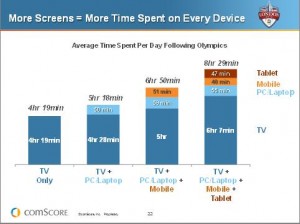 Multi-platform media consumption and the battle of multiple screens has been a growing concern among brand marketers who fear that one device will cannibalize the audience and engagement on another device. However, the fear is unfounded and completely wrong according to research from comScore and NBC. In fact, the study reveals that more devices actually leads to more media consumption.
Multi-platform media consumption and the battle of multiple screens has been a growing concern among brand marketers who fear that one device will cannibalize the audience and engagement on another device. However, the fear is unfounded and completely wrong according to research from comScore and NBC. In fact, the study reveals that more devices actually leads to more media consumption.
The study analyzed media consumption habits for the 2012 London Olympics among an audience who used multiple devices to consume NBC Olympics content on television, computers, laptops, smartphones, mobile phones, and tablet devices. The results showed that using multiple platforms actually led people to view more NBC Olympics content, and engagement levels went up as the number of devices a person used increased.
Eli Goodman of comScore pointed out that not only did participants in the study view more Olympics content, but for individuals who used mobile devices, the amount of time they spent consuming video content on television (the primary channel) and computers (the secondary channel) went up as well. Goodman explained:
“Looking at TV (in this case the primary consumption channel), the average time spent per day consuming Olympics content for TV-only users was 4 hours 19 minutes. But that figure for TV begins to increase among segments accessing content via multiple devices, all the way up to 6+ hours for those who viewed the Olympics across 4 screens. While those who consumed Olympics content across multiple devices may inherently be more engaged viewers, it would also seem that the supplementary channels served to reinforce engagement with the primary channels.”
The image above shows the average time study participants spent per day engaging with Olympics content (click the image to view it at full-size). Goodman points out that brand marketing strategies must be “integrated multi-platform strategies” in order to expand their reach and increase branded content consumption overall.
As with most strategic marketing planning, an integrated strategy is the best strategy. Silo marketing is dead, and today, one element of the marketing plan should feed off of the next. This includes both strategies and tactics related to multi-platform content delivery and consumption.
Do you agree? Leave a comment and share your thoughts.
You can download the complete research report on the comScore website.
Image: comScore
Susan Gunelius is the author of 10 marketing, social media, branding, copywriting, and technology books, and she is President & CEO of KeySplash Creative, Inc., a marketing communications company. She also owns Women on Business, an award-wining blog for business women. She is a featured columnist for Entrepreneur.com and Forbes.com, and her marketing-related articles have appeared on websites such as MSNBC.com, BusinessWeek.com, TodayShow.com, and more.
She has over 20 years of experience in the marketing field having spent the first decade of her career directing marketing programs for some of the largest companies in the world, including divisions of AT&T and HSBC. Today, her clients include large and small companies around the world and household brands like Citigroup, Cox Communications, Intuit, and more. Susan is frequently interviewed about marketing and branding by television, radio, print, and online media organizations, and she speaks about these topics at events around the world. You can connect with her on Twitter, Facebook, LinkedIn, or Google+.


